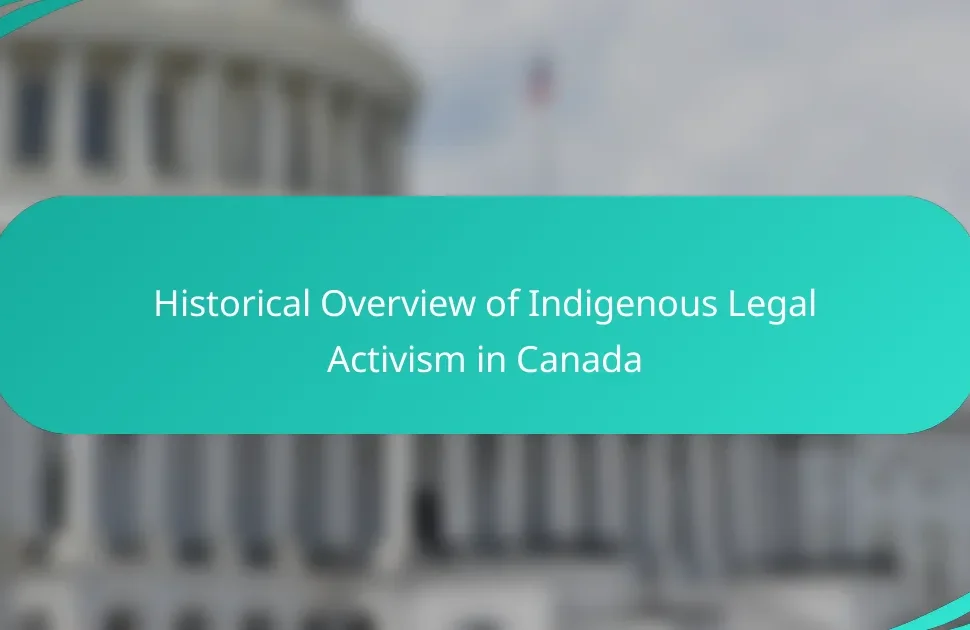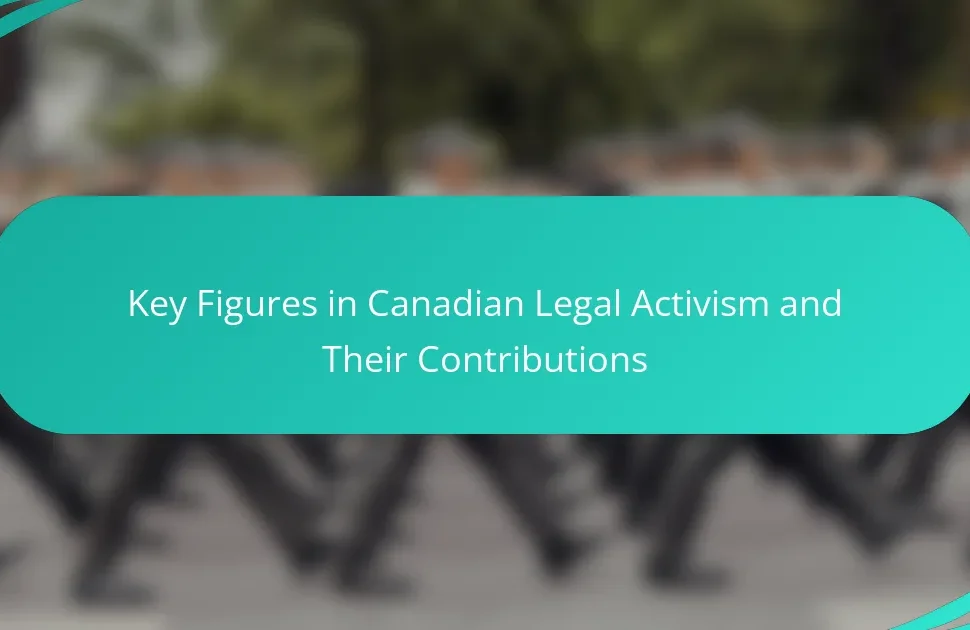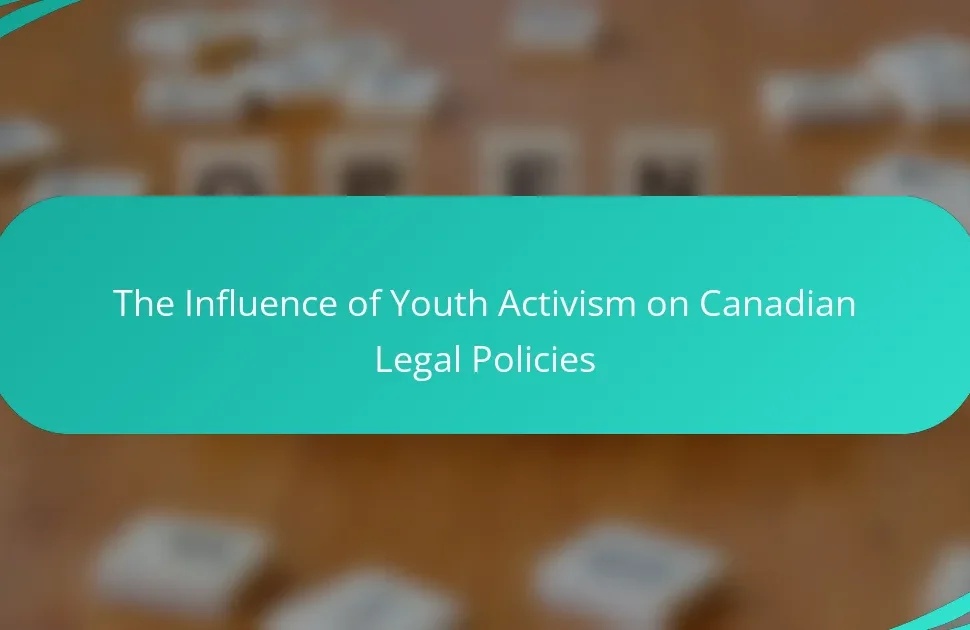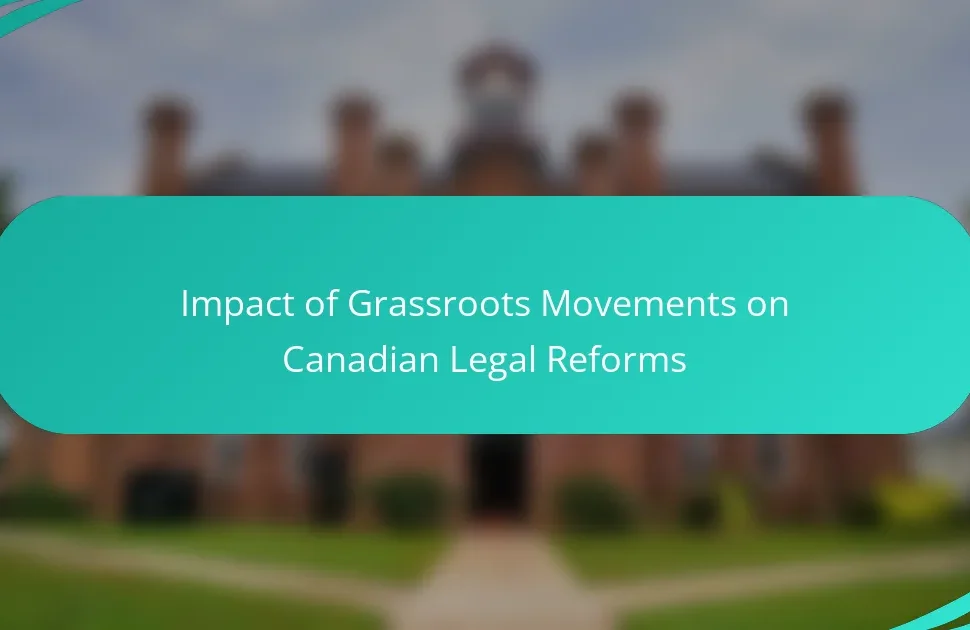
What are Case Studies of Successful Legal Activism in Canadian Communities?
Successful legal activism in Canadian communities includes notable cases such as the “Tsilhqot’in Nation v. British Columbia” decision in 2014. This landmark case recognized the Tsilhqot’in Nation’s land title, affirming Indigenous rights to their ancestral lands. The Supreme Court of Canada ruled that the Tsilhqot’in had established continuous occupation of their territory. This decision has since influenced land negotiations and Indigenous rights across Canada. Another example is the “Carter v. Canada” case, which led to the legalization of assisted dying in 2016. The Supreme Court found that prohibiting assisted dying violated the Canadian Charter of Rights and Freedoms. These cases demonstrate the power of legal activism in advancing social justice and rights within Canadian communities.
How do these case studies illustrate the impact of legal activism?
Case studies illustrate the impact of legal activism by demonstrating tangible changes in laws and policies. They showcase how grassroots movements can challenge injustices effectively. For instance, the case of the Tsilhqot’in Nation led to a landmark Supreme Court ruling. This ruling affirmed Indigenous land rights in British Columbia. Such victories highlight the power of legal frameworks in advancing social justice. Additionally, these cases often mobilize community support and raise awareness. The outcomes create precedents that can influence future legal battles. Overall, they provide concrete evidence of legal activism’s effectiveness in enacting change.
What specific legal challenges were addressed in these case studies?
The specific legal challenges addressed in these case studies include environmental protection issues, Indigenous rights disputes, and access to justice barriers. Environmental protection cases often involve local communities fighting against industrial projects that threaten their land and resources. Indigenous rights disputes frequently center around land claims and treaty violations impacting Indigenous communities. Access to justice barriers highlight the difficulties faced by marginalized groups in obtaining legal representation and navigating the legal system. These challenges illustrate the diverse legal landscapes that activists engage with to achieve community goals.
How did community involvement shape the outcomes of these cases?
Community involvement significantly influenced the outcomes of these cases. Active participation from local residents created a strong support network. This collective action often led to increased visibility of legal issues. For example, community members organized campaigns that drew media attention. Such exposure pressured authorities to address grievances more promptly. Additionally, community involvement facilitated the gathering of crucial evidence. Residents shared firsthand accounts that strengthened legal arguments. Ultimately, these efforts resulted in favorable rulings in several cases. The combined actions of individuals demonstrated the power of grassroots activism in shaping legal outcomes.
Why is legal activism important in Canadian communities?
Legal activism is important in Canadian communities because it promotes social justice and protects individual rights. It empowers marginalized groups by giving them a voice in legal matters. Legal activism can lead to significant legislative changes that benefit society as a whole. For example, successful legal challenges have resulted in the recognition of Indigenous land rights. These actions often raise public awareness about critical issues, fostering community engagement. Legal activism also holds governments accountable, ensuring they adhere to the rule of law. In Canada, historical cases have demonstrated the effectiveness of legal activism in advancing civil rights. Overall, it plays a crucial role in shaping a fair and equitable society.
What role does legal activism play in promoting social justice?
Legal activism plays a crucial role in promoting social justice by challenging unjust laws and practices. It empowers marginalized communities to seek legal redress and advocate for their rights. Through strategic litigation, legal activists highlight systemic inequalities and push for reforms. Historical examples include the civil rights movement, where legal challenges led to significant legislative changes. In Canada, cases like R v. Sparrow demonstrate how legal activism can protect Indigenous rights. Legal activism also raises public awareness and mobilizes community support for social justice issues. Ultimately, it serves as a vital tool for achieving equity and accountability in society.
How can legal activism influence policy changes in communities?
Legal activism can influence policy changes in communities by mobilizing public support and raising awareness about critical issues. Through strategic litigation, activists can challenge unjust laws and practices. This approach often leads to judicial rulings that set precedents for future cases. For example, the Supreme Court of Canada has ruled in favor of Indigenous land rights, prompting policy reforms. Legal activism also engages stakeholders, including policymakers and community members, fostering dialogue and collaboration. By presenting compelling evidence and testimonies, activists can sway public opinion and encourage legislative action. Overall, legal activism serves as a catalyst for social change and community empowerment.

What are some notable examples of successful legal activism in Canada?
The Supreme Court of Canada’s decision in R v. Morgentaler (1988) is a notable example of successful legal activism. This case decriminalized abortion, affirming women’s rights over their reproductive choices. The ruling was influenced by extensive advocacy from women’s rights groups.
Another significant case is the Tsilhqot’in Nation v. British Columbia (2014). This landmark decision recognized Aboriginal land rights. It affirmed the Tsilhqot’in Nation’s title to their traditional territory. This ruling was a result of decades of legal battles and activism by Indigenous groups.
Additionally, the case of Carter v. Canada (2015) led to the legalization of assisted dying. The Supreme Court ruled that prohibiting assisted suicide violated the Charter of Rights. This decision was shaped by the advocacy of patients and disability rights activists.
These examples illustrate the impact of legal activism in shaping Canadian law and advancing social justice.
How did specific communities achieve success through legal activism?
Specific communities achieved success through legal activism by mobilizing collective action to address injustices. They utilized the legal system to challenge discriminatory laws and policies. For instance, the Indigenous communities in Canada successfully fought for land rights through the Calder case in 1973. This landmark decision recognized Aboriginal title, leading to significant legal reforms. Similarly, the [censured] community in Ontario achieved marriage equality through the Halpern case in 2003. This case set a precedent that influenced national legislation. Legal activism often involved strategic litigation, public awareness campaigns, and coalition-building with other organizations. These efforts resulted in tangible changes in laws and policies, improving the rights and lives of marginalized groups.
What strategies were employed in these successful cases?
Successful cases of legal activism in Canadian communities employed strategies such as community mobilization, coalition building, and strategic litigation. Community mobilization involved grassroots efforts to raise awareness and gather support for legal issues. Coalition building brought together various stakeholders, including non-profits, local organizations, and affected individuals, to strengthen advocacy efforts. Strategic litigation focused on using the legal system to challenge injustices and set precedents. For example, the case of *R v. Morgentaler* utilized strategic litigation to advance reproductive rights in Canada. These strategies collectively contributed to the effectiveness of legal activism in achieving social change.
What were the key factors contributing to their success?
Key factors contributing to their success include community engagement, strategic partnerships, and effective communication. Community engagement fostered strong local support and mobilized volunteers. Strategic partnerships with organizations provided resources and expertise. Effective communication ensured the message resonated with a broader audience. These elements collectively strengthened their advocacy efforts. For instance, successful campaigns often utilized social media to amplify their reach. This approach led to increased awareness and participation in legal activism.
What lessons can be learned from these case studies?
Lessons from these case studies include the importance of community engagement. Successful legal activism often relies on the active participation of community members. Collaboration among various stakeholders enhances the effectiveness of legal strategies. Building strong coalitions can amplify voices and increase resources. Additionally, understanding local laws and regulations is crucial for effective advocacy. Tailoring approaches to specific community needs leads to better outcomes. Persistence in the face of challenges is also a key takeaway. Many successful cases demonstrate that sustained efforts can yield significant change.
How can communities replicate successful legal activism efforts?
Communities can replicate successful legal activism efforts by analyzing and adopting proven strategies from past cases. They should identify key legal issues relevant to their context. Engaging local stakeholders is crucial for building support and resources. Establishing coalitions with like-minded organizations enhances collective strength. Communities must utilize effective communication strategies to raise awareness and mobilize participation. Documenting and sharing successes can inspire further efforts and attract funding. Training community members in legal processes empowers grassroots activism. Historical examples, such as the Indigenous land rights movements in Canada, demonstrate the effectiveness of these approaches.
What common challenges do communities face in legal activism?
Communities face several common challenges in legal activism. Limited financial resources often hinder their ability to pursue legal action. Many communities lack access to legal expertise, which complicates their efforts. Additionally, there is often a lack of awareness about legal rights among community members. This can lead to underrepresentation in legal matters.
Furthermore, communities may experience institutional resistance from government entities or corporations. This resistance can create barriers to achieving desired legal outcomes. Time constraints also pose a challenge, as legal processes can be lengthy and exhausting. Lastly, communities may struggle with internal divisions that weaken their collective efforts. These factors collectively impede effective legal activism.
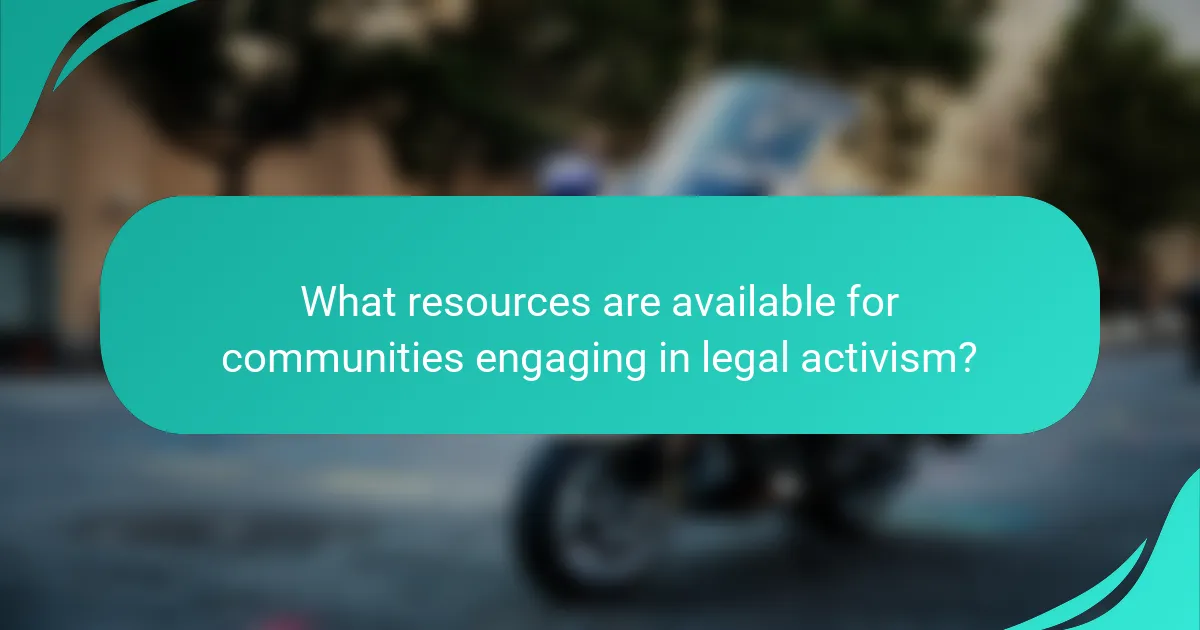
What resources are available for communities engaging in legal activism?
Communities engaging in legal activism can access various resources. Legal aid organizations offer free or low-cost legal services. Advocacy groups provide support and guidance on specific issues. Online platforms facilitate information sharing and collaboration among activists. Educational workshops enhance understanding of legal rights and processes. Funding opportunities exist through grants aimed at supporting community initiatives. Local law schools often provide pro bono assistance through student clinics. Networking events connect activists with experienced legal professionals. These resources empower communities to effectively pursue legal activism.
How can communities access legal support and resources?
Communities can access legal support and resources through various channels. Local legal aid organizations provide free or low-cost legal assistance. Many communities have nonprofit groups focused on specific legal issues, such as immigration or housing. Public libraries often offer access to legal resources and guides. Online platforms provide information and connect individuals with legal professionals. Community centers may host legal clinics offering consultations. Law schools frequently run legal aid programs staffed by students under supervision. These resources ensure communities have essential legal support for their needs.
What organizations provide assistance for legal activism?
Organizations that provide assistance for legal activism include the Canadian Civil Liberties Association (CCLA), the Legal Aid Society, and the David Asper Centre for Constitutional Rights. The CCLA focuses on protecting civil liberties and promoting social justice. The Legal Aid Society offers legal representation and resources to low-income individuals. The David Asper Centre specializes in constitutional law and supports public interest litigation. These organizations have a history of contributing to significant legal cases and advocacy efforts. They provide resources, training, and legal support to empower communities in their activism.
What tools are available for effective community organizing?
Effective community organizing tools include digital platforms, communication apps, and collaborative software. Digital platforms like Facebook and Twitter facilitate outreach and engagement. Communication apps such as WhatsApp and Slack enable real-time discussions among organizers. Collaborative software like Google Drive allows for shared document editing and planning. Additionally, survey tools like SurveyMonkey help gather community input. Event management tools like Eventbrite streamline organizing gatherings. Data visualization tools like Tableau assist in presenting community issues clearly. These tools have been utilized in various successful community organizing efforts across Canada, demonstrating their effectiveness in mobilizing support and fostering collaboration.
What best practices should communities follow for successful legal activism?
Communities should engage in thorough research to understand legal frameworks. This knowledge enables informed advocacy efforts. Building coalitions with like-minded organizations strengthens collective action. Diverse voices enhance the legitimacy of activism. Establishing clear objectives helps maintain focus and direction. Utilizing social media effectively raises awareness and mobilizes support. Documenting activities and outcomes provides evidence for future actions. Continuous education on legal rights empowers community members.
How can communities build coalitions for legal activism?
Communities can build coalitions for legal activism by identifying shared goals and interests. This process begins with gathering stakeholders who are affected by similar legal issues. Open communication fosters trust and collaboration among these stakeholders. Organizing regular meetings allows for the exchange of ideas and strategies. Utilizing social media can enhance outreach and engagement with a broader audience. Establishing clear roles and responsibilities ensures effective participation. Collaborating with legal experts can provide valuable insights and support. Successful coalitions often leverage existing community organizations to amplify their efforts. For instance, the BC Civil Liberties Association has effectively mobilized community members for legal advocacy in British Columbia.
What are effective communication strategies for legal campaigns?
Effective communication strategies for legal campaigns include clear messaging, targeted outreach, and consistent branding. Clear messaging ensures that the campaign’s goals and legal arguments are easily understood. Targeted outreach involves identifying and engaging key stakeholders, such as community leaders and affected individuals. Consistent branding helps to create a recognizable identity for the campaign, fostering trust and solidarity. Utilizing social media platforms can enhance visibility and engagement with a broader audience. According to a study by the American Bar Association, strategic communication significantly impacts public perception and support for legal initiatives.
The main entity of the article is successful legal activism in Canadian communities. The article examines notable case studies, such as “Tsilhqot’in Nation v. British Columbia” and “Carter v. Canada,” which highlight the impact of legal activism on social justice and individual rights. It discusses the specific legal challenges addressed, the role of community involvement, and the strategies employed in these cases. Additionally, the article explores the importance of legal activism in promoting social justice, the resources available for communities, and best practices for effective legal organizing.

